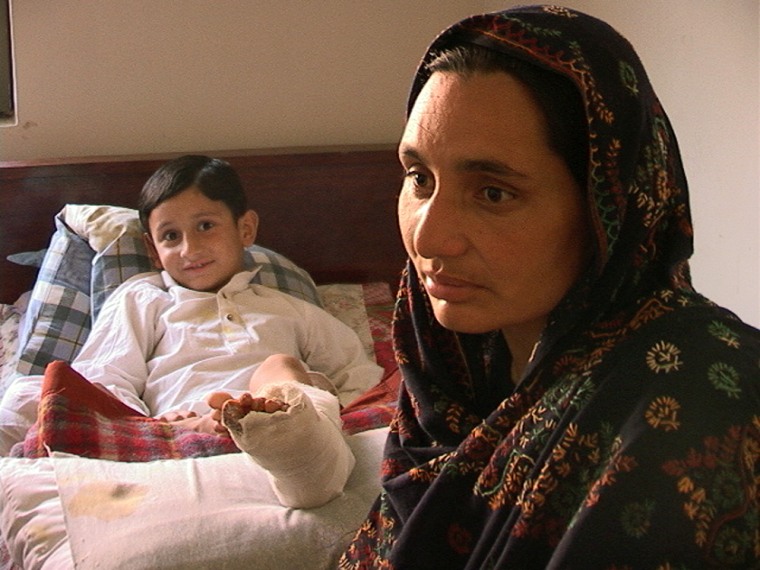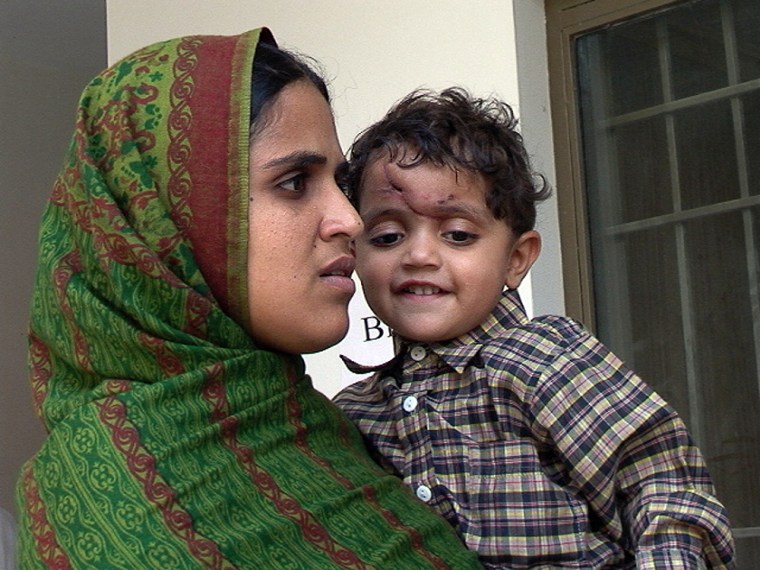Zoya Zahoor clung to her mother at first, but warmed up within seconds to the attention of strangers.
Flashing her huge brown eyes, she began laughing and handing out little plastic soldiers from the stash in her pocket.
The three-year old seemed oblivious to a four-inch scar that circles her forehead and the flat spot on the back of her head where her skull was compressed by falling debris.
“She had a huge cut on her head," said her mother, Saida Nousrad,as she recalled pulling Zoya from the wreckage of their home minutes after the 7.6 magnitude earthquake that struck northern Pakistan on Oct.8.
"I could see through to her skull and her skin was on the ground,” she added,“but when I pulled her out, she was laughing."
Nousrad, who lost 50 relatives from her extended family that day, admires her daughter's innocent ability to laugh in such cirmcumstances. Her concerns are many — Zahoor’s father is injured and she says she never wants to return to the stricken city of Muzaffarabad, where their house is in ruins.
But she is grateful to be with her daughter in an impressive transitional hospital in Pakistan's capital, Islamabad, where Zahoor and other children can stave off uncertainty and recover from their injuries.
Dorm turned extended care facility
Thanks to an idea from the Pakistan Ministry of Social Welfare and Special Education and a non-governmental organization called Women Aid Trust, the children are recovering from their wounds in a gold-standard facility for youngsters whose conditions have stabilized enough to recover in the company of family but are not yet ready to travel.
It’s the perfect marriage: an empty dormitory that can house up to 200 people in a pinch and a throng of children just released from hospital with no place to call home. In one day, the space, an ochre-colored government building with a guard at the door and a garden and sunny courtyards in the back, was transformed into an extended-care facility.

A little piece of comfort and calm
The first thing a visitor notices are the smiles on the faces of the children.
A little boy happily bounced a marble on the tile floor, and then raced down the corridor once he spotted a visitor, only to peer back, smiling from behind a door where he commenced a game of peek-a-boo.
Other children surrounded a teacher in a makeshift classroom, sitting with parents and brothers and sisters as they exchanged smiles with volunteers who came in to chat with them.
The fact that these children were enjoying normal moments so soon after the disaster that brought their schools and homes crashing down was humbling.
The parents also looked comparitively calm. Instead of bleak desperation, there was concern on their faces as they watched the children. This place, where earthquake survivors have come to heal for a bit before moving on to uncertain futures, is, against all odds, a happy place.
Children’s play
Susan Hirshberg, consultant to the Ministry of Social Welfare and co-director of the center, knows most of the children by name and can coax a smile from almost all of them.
In the learning center where teachers lead children in art projects and other activities, paintings of hand and foot prints adorn the wall, along with paper cut-outs donated by local school children.
Hirshberg pointed to a favorite: a single footprint made by a girl whose foot was the only thing not in a cast.
The center has benefited from the generous donations and has been able to provide enough food for three high-calorie meals a day as well as snacks, blankets, clothing, toys and other items for the children and their families. Volunteers cheerfully interact with children and direct the inflow of donations and new volunteers.
Wounds – both invisible and visible - treated
For those who need follow-up care, doctors and nurses are on duty day and night. A guard at the door stops unwelcome visitors from coming in and unaccompanied children from going out — one little girl who was turned back after several attempts to follow her brother who was discharged before her.
The only place that truly recalls the horror of the earthquake is the changing room, a place you hear before you see. Children screamed as doctors cleaned and examined wounds, and changed bandages.
Psychologists also treat the invisible wounds left by trauma. After Hirshberg tried, but failed, to get a smile from a wan boy with a broken leg, she noted that he may need a psychologist.
Families deal with uncertain future
That kind of help doesn't appear to be necessary for 6-year-old Zein Manzoor, who broke his leg when his school collapsed, killing six of his classmates. Despite being trapped in the rubble for two hours before his teacher freed him, he has a smile on his face.
Zein’s father and mother are anxious to return to the village of Nadakot even though an uncle warned them by phone that there are no winterized tents, food, medicine or medical care, and that there were still injured people in the village awaiting medical care.
“At least we will be together,” explained his Zein’s mother, Nargiz Manzoor. “We will start from scratch.” She was worried about those they left behind. “Although we are well taken care of, the villagers are devastated and there is no one to care for them.”
Hirshberg said most parents are anxious to go back to their villages despite impending winter. But they cannot take an injured child from the center until they are discharged by doctors and the staff is convinced the child no longer needs medical care or can obtain needed care if they travel.
To meet the need to keep families together, the organization is opening a second hostel for women and children only.
A warm place to heal
Zoya Zahoor, along with her mother and older sister, will be among the first residents of the new hostel. Hirshberg considers the enclosed space a safer environment for two little girls than the tent city in which their father will live.
Unlike millions of earthquake survivors in northern Pakistan, Zahoor and her family will stay warm, dry and well fed this winter as wounds heal and they begin a new life in Islamabad.
